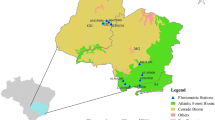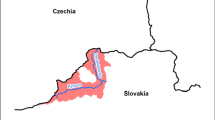Abstract
This article presents the results of analysis of relationships between stream regulations and the geomorphic effects of floods for the case of the Blanice river basin in the Czech Republic, which was at the center of an extreme flooding event that impacted Central Europe in August 2002. The assessment is based on a geostatistical analysis of data on the distribution of flood effects and stream modifications acquired by field survey and completed by historical maps and digital cartography. Using the cluster analysis and regression tree classification, relationships between the occurrence of erosion and deposition forms, and the parameters of stream modification and general physiography were tested. The results indicate a limited relationship between stream modifications and the occurrence of geomorphic effects of the flood. The cluster analysis detected different sets of parameters linked to erosion and accumulation. The accumulation was related to physiographic properties of stream, while erosion was related to the presence of weirs in the stream segment. The regression tree classification demonstrates the potentially critical combinations of stream modifications related to the occurrence of flood effects.








Similar content being viewed by others
References
Addinsoft (2009) XLStat 2009. Addinsoft, Paris
Bičík I, Kupková L, Štych P (2003) Development of landuse structure in the Otava River Basin in 1845–1948–1990. Acta Universitatis Carolinae—Geographica 38(2):79–96
Birkland TA, Burby RJ, Conrad D, Cortner H, Michener WK (2003) River ecology and flood hazard mitigation. Natural Hazards Rev 4(1):46–54
Blackwell M, Maltby E (2006) Ecoflood guidelines: how to use floodplains for flood risk reduction. European Commission, Luxembourg
Brath A, Montanari A, Moretti G (2006) Assessing the effect on flood frequency of land use change via hydrological simulation (with uncertainty). J Hydrol 324(1–4):141–153
Breiman L, Friedman JH, Olshen RA, Stone CJ (1998) Classification and regression trees. Chapman & Hall/CRC, Boca Raton
Camorani G, Castellarin A, Brath A (2005) Effects of land-use changes on the hydrologic response of reclamation systems. Phys Chem Earth Parts A/B/C 30(8–10):561–574
CEN (2005) CEN/TC230/WG2/TG5 prEN 14614. Water quality. Guidance standard for assessing the hydromorphological features of rivers. CEN, Brussels
Crooks S, Davies H (2001) Assessment of land use change in the Thames catchment and its effect on the flood regime of the river. Physics and chemistry of the earth, part B: hydrology. Ocean Atmos 26(7–8):583–591
Fohrer N, Haverkamp S, Eckhardt K, Frede HG (2001) Hydrologic response to land use changes on the catchment scale. Physics and chemistry of the earth, part B: hydrology. Ocean Atmos 26(7–8):577–582
Gilvear D (1999) Fluvial geomorphology and river engineering: future roles utilizing a fluvial hydrosystems framework. Geomorphology 31(1–4):229–245
Helms M, Bu B (2002) Statistical analysis of the ood situation and assessment of the impact of diking measures along the Elbe (Labe) river. Data Base 267:94–114
Janauer GA (2000) Ecohydrology: fusing concepts and scales. Ecol Eng 16(1):9–16
Křížek M, Engel Z (2003) Geomorphological consequences of the 2002 flood in the Otava river drainage basin. Acta Universitatis Carolinae—Geographica 38(2):125–138
Langhammer J (2007) HEM—methodology for the monitoring of hydromorphological parameters of ecological quality of watercourses. Ministry of Environment of Czech Republic, Prague
Langhammer J (2008) Identification of floodplain elements suitable for use in integrated flood protection using hydromorphological mapping. Case study: upper Opava river basin. Moravian Geogr Rep 16(2):36–46
Langhammer J, Sitař J (2008) Modelling the impact of anthropogenic modifications to river channels on the course of extreme floods. Case study: August 2002 flood, Blanice river basin, Czechia. Geografie–Sborník ČGS 113(3):27–37
Langhammer J, Vajskebr V (2003) Historical shortening of river network in the Otava river basin. Acta Universitatis Carolinae—Geographica 38(2):109–124
Magilligan FJ, Phillips JD, James LA, Gomez B (1998) Geomorphic and sedimentological controls on the effectiveness of an extreme flood. J Geol 106(1):87–96
O′Connell E, Ewen J, O′Donnell G, Quinn P (2007) Is there a link between agricultural land-use management and flooding? Hydrol Earth Syst Sci 11(1):96–107
Pinter N, Schweigert P, Hoefer G (2006) Flood magnification on the River Rhine. Hydrol Process 20(1):147–164
Plate EJ (2002) Flood risk and ood management. J Hydrol 267:2–11
Poff NL, Allan JD, Bain MB, Karr JR, Prestegaard KL, Richter BD et al (1997) The natural flow regime. Bioscience 47(11):769–784
Rodriguez-Iturbe I (2000) Ecohydrology: a hydrologic perspective of climate–soil–vegetation dynamics. Water Resour Res 36(1):3–9
Stehlík J (2003) Meteorological causes of flood situations in the Otava river basin. Acta Universitatis Carolinae—Geographica 38(2):65–78
Vlasák T (2003) Overview and classification of historical floods in the Otava river basin. Acta Universitatis Carolinae—Geographica 38(2):49–64
VÚV (2008) DIBAVOD. Digital Water Management Map. Water Research Institute TGM, Prague
Yin H, Li C (2001) Human impact on floods and flood disasters on the Yangtze river. Geomorphology 41(2–3):105–109
Zalewski M (2000) Ecohydrology—the scientific background to use ecosystem properties as management tools toward sustainability of water resources. Ecol Eng 16(1):1–8
Zielinski T (2003) Catastrophic flood effects in alpine/foothill fluvial system (a case study from the Sudetes Mts, SW Poland). Geomorphology 54(3–4):293–306
Zimmermann A, Church M (2001) Channel morphology, gradient profiles and bed stresses during flood in a step-pool channel. Geomorphology 40(3–4):311–327
Acknowledgments
This research was funded by the Research Scheme MSM 0021620831, “Geographical Systems and Risk Processes in the Context of Global Changes and European Integration.” and the project QH82078 Water retention in floodplains and its stimulation. The author would like to thank the field mappers who assisted with data collection and digitizing.
Author information
Authors and Affiliations
Corresponding author
Rights and permissions
About this article
Cite this article
Langhammer, J. Analysis of the relationship between the stream regulations and the geomorphologic effects of floods. Nat Hazards 54, 121–139 (2010). https://doi.org/10.1007/s11069-009-9456-2
Received:
Accepted:
Published:
Issue Date:
DOI: https://doi.org/10.1007/s11069-009-9456-2




